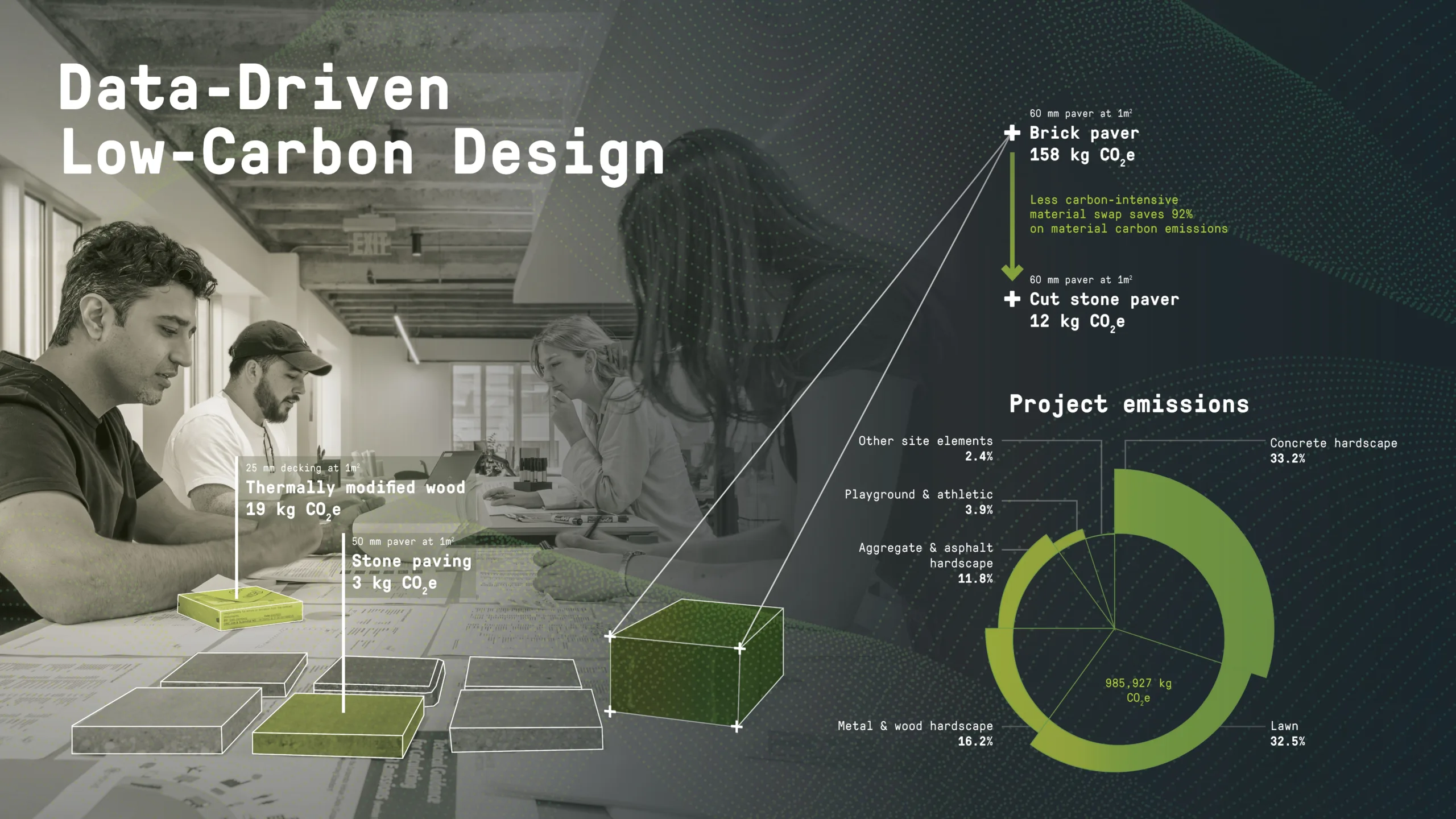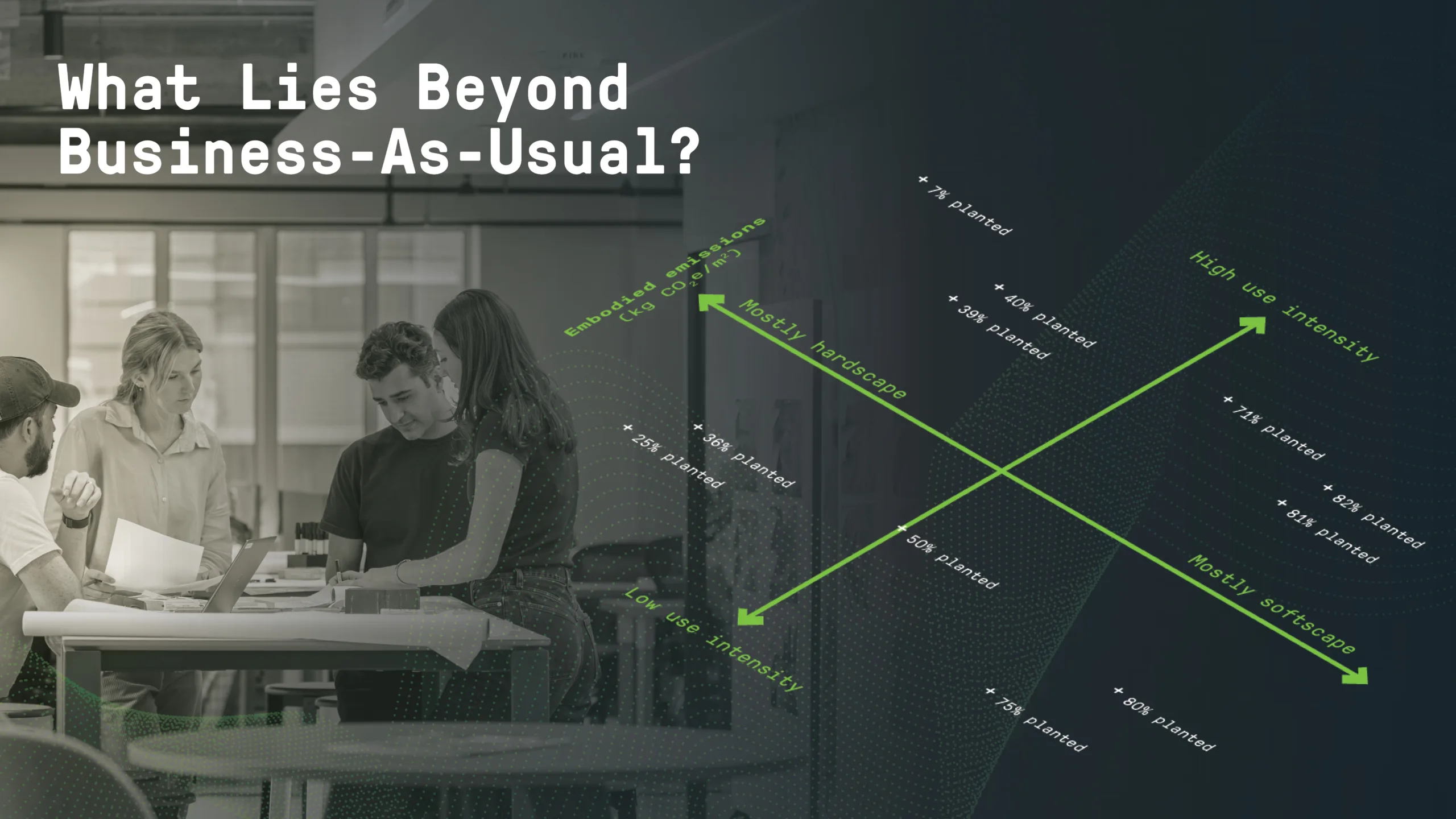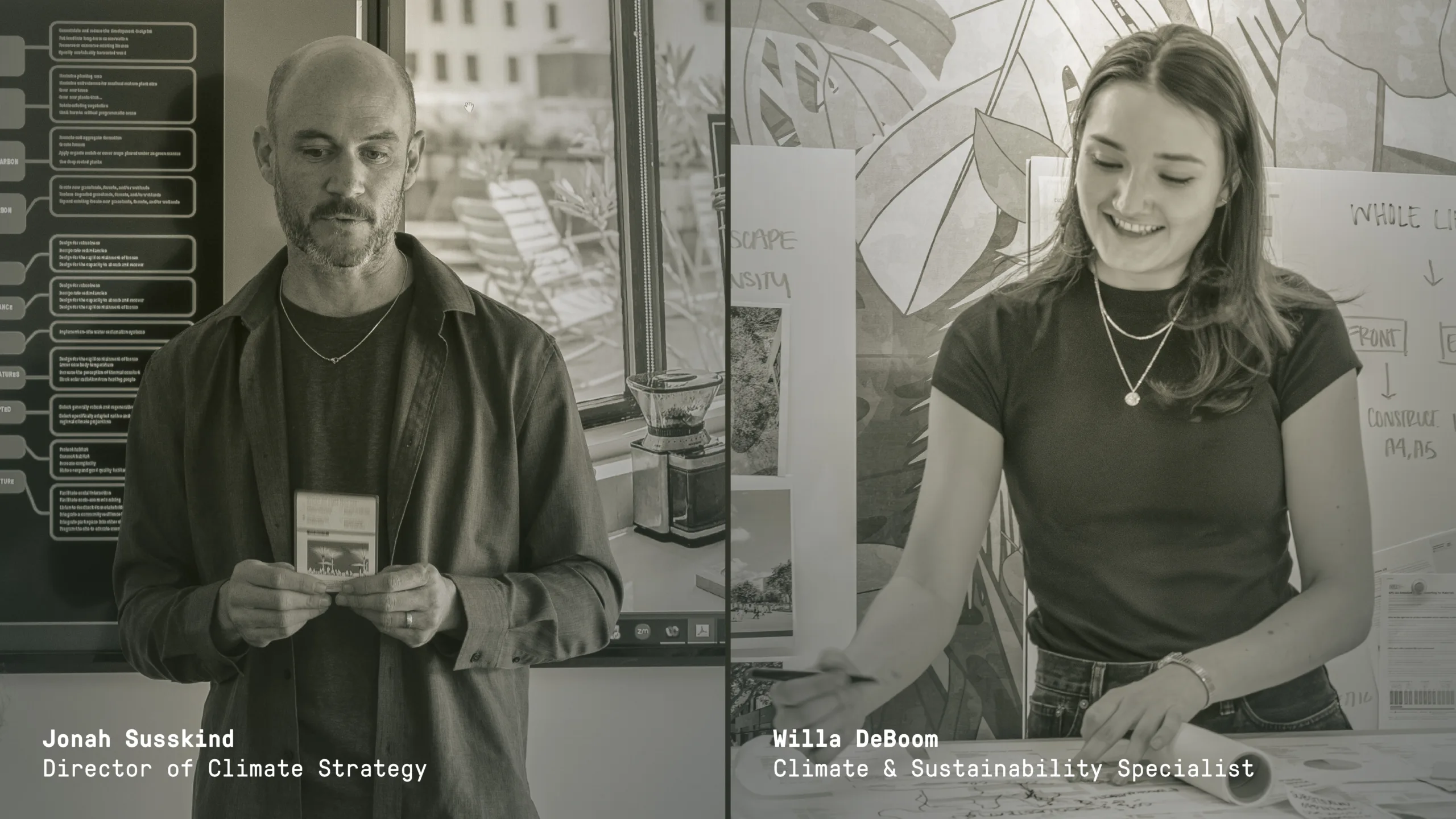50% of What? Establishing a Carbon Baseline in Landscape Architecture

November marks a year since the release of SWA’s Climate Action Plan (CAP)—the first released by a major landscape architecture firm. Over the past year, our Climate & Sustainability team has worked across studios to turn ambitious targets into day-to-day practice. Rather than claiming to have all the answers, our new series, The Low-Carbon Landscape, will reflect on what’s working, what’s surprising, and where uncertainty remains, in order to share lessons and spark dialogue across the profession.
In this opening piece, Director of Climate Strategy Jonah Susskind looks at the CAP’s core ambition to cut the carbon footprint of our built work by 50% by 2030, raising a question both deceptively simple and critical: 50% of what?
Over the past decade, Climate Action Plans have become a defining framework across industries. In a mounting call for government and corporate action, the 1997 Kyoto Protocol, 2015 Paris Agreement, 2016 UN Sustainable Development Goals, and 2018 IPCC Special Report on Global Warming of 1.5°C called on companies worldwide to set science-based targets for reducing greenhouse gas emissions and mitigating disastrous climate impacts to vulnerable populations across the globe.
In AEC, a flurry of commitments followed suit. The AIA 2030 Commitment (2009) set early and ambitious targets for architects. MEP 2040 (2021) challenged building systems engineers to advance them further. Most recently, the ASLA Climate Action Plan (2022) established a profession-wide roadmap for landscape architecture. All share a common principle: targets must be measured against a credible baseline. While architects and engineers now rely on industry-wide data and standardized reporting frameworks, landscape architecture still lacks the infrastructure to track and verify progress at scale.
Without a baseline, 50% is an aspirational but not actionable goal. So, over the past year, SWA’s Climate & Sustainability Team conducted a series of 10 case studies to measure embodied carbon across project types, scales, and contexts, in order to better understand the full breadth of work and impact that carbon-conscious design efforts could make.

You can’t manage what you can’t measure.
Rather than selecting projects by typology, the team organized these case studies through a carbon lens—for instance, the percentage of a site that was planted versus hardscape; the intensity of use it supports; etc. To aid in this process, the team read up on best practices for analyzing embodied carbon across a full project lifecycle, from material and plant selection through construction, demolition, and maintenance.
Running this data through various modeling softwares and databases, the team began building custom spreadsheets to support efficient material inventories, track questions and assumptions, and fill in gaps along the way. For each case study, self-designated Climate Champions in each studio gathered drawings, CAD files, cost estimates, and other assets to tally the quantity of materials like concrete, steel, and plants, apply carbon factors to them, and build analytical profiles of each using Climate Positive Design’s Pathfinder tool. The process required hundreds of person-hours, weeks of coordination across studios, and more than a few late-night troubleshooting sessions — the kind of messy, iterative work that real progress often depends on.
The results were both intuitive and eye-opening. To nobody’s surprise, hardscape-intensive projects like entertainment venues and urban plazas showed much higher embodied emissions than plant-rich projects like parks and greenways, some of which may sequester enough carbon over the years to nullify their original footprint. We found that even our least carbon-intensive projects carried a measurable impact, emitting roughly as much greenhouse gas per acre as 30 gas-powered cars driving for a full year. Projects with the highest carbon footprints were nearly twenty times higher.
More insights are sure to come as we continue to build carbon modeling deeper into our project work, but for the first time, this process illustrated within clear data what a typical emissions baseline for “business-as-usual” design looks like across a range of geographies and scales. While this wasn’t the first time our team had performed in-depth carbon analysis, we made sure to stress test our findings, revisiting material specifications and experimenting with substitutions—salvaged concrete instead of new; local stone instead of imported; recycled steel instead of virgin stock.
Across all 10 projects, we found that average emissions could be reduced by ~40% without compromising design intent. In some cases, we reached a full 50% reduction target simply through smarter material choices.

Why share the messy middle?
While architects and engineers have long relied on established carbon modeling platforms like One Click LCA, Tally, EC3, and C-Scale, landscape architects are still in the early days of testing software, filling data gaps, and adapting workflows accordingly. Today, tools like Pathfinder and Sasaki’s Carbon Conscience offer invaluable, high-level insights into firms’ performance while working through back-end updates to their databases.
At this early stage in the field’s overall work around emission reductions, each firm and individual caught in the messy process of “learning by doing” makes a valuable contribution to our collective efforts as a profession. By sharing our process, warts and all, the hope is that others will test, challenge, and build upon our process, get in touch, and help our extended professional network push for a lower-carbon future.
Next up, we’ll be exploring how CAPs and decarbonization efforts have already shifted the culture of design across the landscape architecture field, situating our own efforts within a profession-wide reckoning with carbon-intensive materials and processes.

Decarbonization Dictionary
As we begin to share this work, we recognize jargon can be a barrier to engagement for people just beginning to learn about low-carbon design. Below, we’ve defined a few basic terms as a quick primer.
Embodied carbon
The overall amount of greenhouse gas emissions tied to the full lifecycle of materials used in a project—including their extraction, manufacturing, transport, construction, and disposal.
Operational carbon (project scale)
The overall amount of emissions associated with a project’s long-term operations and maintenance—for instance, energy consumption related to lighting, heating, cooling, or water pumping. For landscapes, this amount is usually smaller than embodied carbon, but still important to measure.
Operational carbon (organizational scale)
The emissions associated with a business’ daily operations (i.e. travel, staff commutes, office electricity, heating, and cooling, etc.).
Carbon sequestration
The process by which carbon dioxide is removed from the atmosphere and is stored in organic material like plants, soil, water bodies, and other matter. Areas that sequester and store large amounts of atmospheric carbon, like oceans, wetlands, and forests, are often called “carbon sinks.”
Life cycle assessment (LCA)
A detailed analysis measuring environmental impact across the full life of a material—from its raw extraction (“cradle”) through its processing, use, and eventual disposal or destruction (“grave”). At its core, an LCA is a tool to quantify the environmental impact of different materials to weigh the benefits and downsides of different specification options and make better choices.
Carbon assessment
Also termed “carbon accounting” and “carbon modeling,” this is the process of measuring a given project’s carbon footprint.
Net zero
A widely used and often misunderstood term referring to a project or firm’s capacity to produce enough energy—through measures like solar panels, geothermal wells, carbon credits, or otherwise—to offset overall energy consumed. In AEC, this is often used as a marketing shorthand to target or celebrate emission reduction efforts, but a true “net zero” project must balance all emissions with equivalent reduction or sequestration—not just reduce part of its total footprint.

